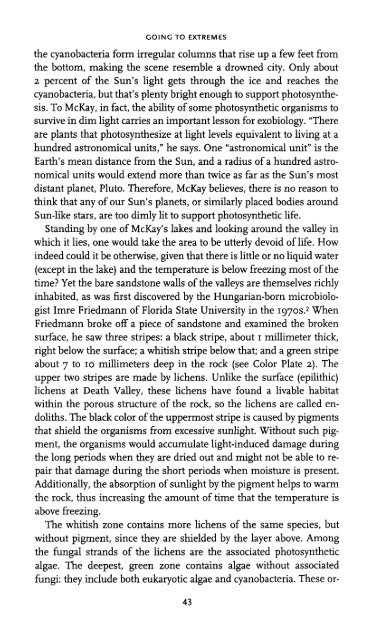Create successful ePaper yourself
Turn your PDF publications into a flip-book with our unique Google optimized e-Paper software.
HERE BE DRAGONS<br />
including life—and certainly, water seems like the most natural place<br />
for a Life to get started: it's an excellent solvent, and there's plenty of it,<br />
on Earth at least. But water alone isn't enough. Terrestrial life is made<br />
of carbon-containing molecules—organic compounds—many of<br />
which also contain nitrogen, oxygen, and other elements. And assembling<br />
these molecules takes energy.<br />
As mentioned earlier, Charles Darwin publicly expressed a belief<br />
that Earth's first creatures were divinely made. Perhaps he felt that he<br />
had rocked the boat sufficiently with his theory of evolution—that he<br />
would endanger the seaworthiness of his whole enterprise if he went<br />
further. But in a private letter, written in 1871, he did put forward the<br />
idea that life arose spontaneously, "in some warm little pond, with all<br />
sorts of ammonia and phosphoric salts, light, heat, electricity, etc.<br />
present."<br />
If so, what were these chemicals and where did they come from In<br />
1936 the Russian chemist A.I. Oparin suggested an answer. 4 The<br />
Earth's early atmosphere, he proposed, was rich in ammonia (NH 3 )<br />
and methane (CH 4 ), and lacked oxygen. In this "reducing" (hydrogendonating)<br />
atmosphere, a large variety of organic molecules formed<br />
and were washed by rain into the ocean, gradually building up a "prebiotic<br />
soup." (The "soup" metaphor was actually introduced by the<br />
British geneticist J.B.S. Haldane, who had been thinking independently<br />
along the same lines.) The very first organisms, Oparin believed,<br />
were extremely simple: they didn't need to have complex metabolic<br />
pathways because everything was available in the soup—both molecules<br />
to make up their structure (such as amino acids) and molecules<br />
to break down for energy. It was the ultimate free lunch. Eventually, of<br />
course, the goodies ran out, and organisms had to learn how to make<br />
an honest living. However long that initial period may have lasted—a<br />
hundred thousand years, a million years, ten million years—it could<br />
have been no more than a moment in the Earth's history.<br />
One of the La Jolla scientists, Stanley Miller of the UCSD Chemistry<br />
Department, tested Oparin's ideas in the laboratory. In 1952, as a graduate<br />
student working in the laboratory of Harold Urey at the<br />
University of Chicago, Miller performed an experiment that made<br />
him famous and established origin-of-life research as an experimental<br />
science. 5 He tested Oparin's hypothesis by (i) filling a flask with a "reducing<br />
atmosphere" (he chose a mixture of methane, ammonia, and<br />
hydrogen gas—H 2 ) over an "ocean" (a cupful or so of water) and (2)<br />
subjecting the milieu to "lightning strikes" (electrical discharges).<br />
18













